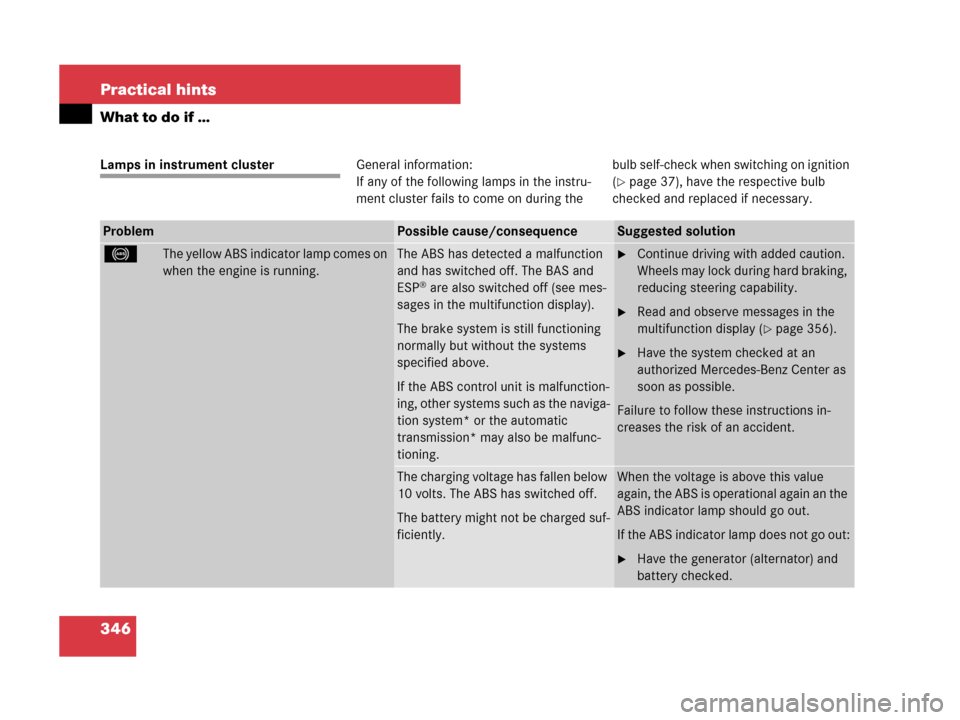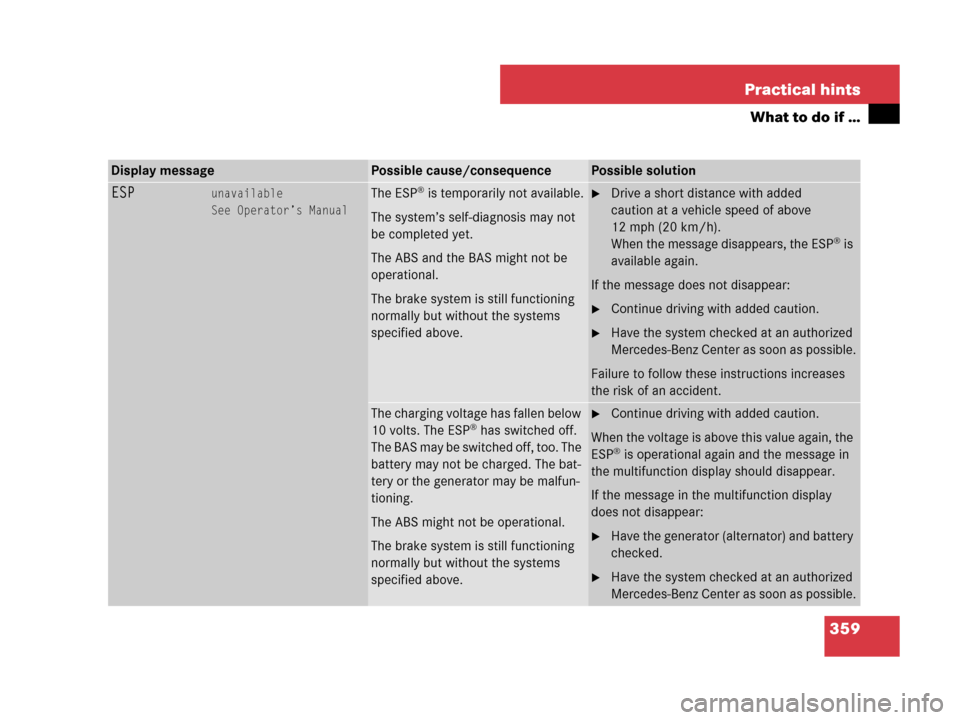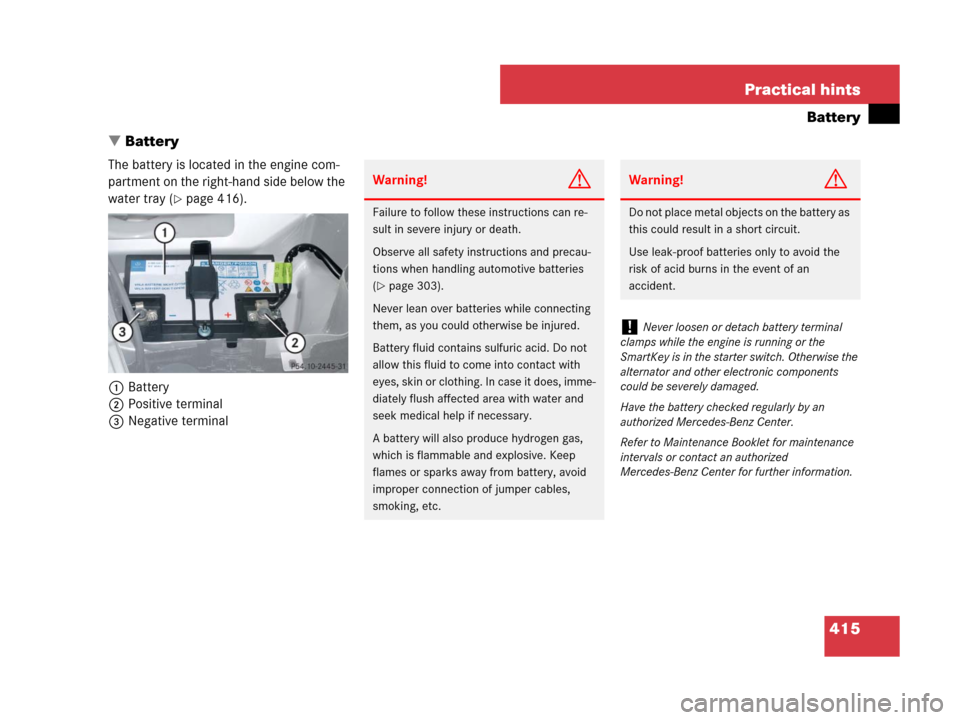Page 347 of 473

346 Practical hints
What to do if …
Lamps in instrument clusterGeneral information:
If any of the following lamps in the instru-
ment cluster fails to come on during thebulb self-check when switching on ignition
(
�page 37), have the respective bulb
checked and replaced if necessary.
ProblemPossible cause/consequenceSuggested solution
-The yellow ABS indicator lamp comes on
when the engine is running.The ABS has detected a malfunction
and has switched off. The BAS and
ESP
® are also switched off (see mes-
sages in the multifunction display).
The brake system is still functioning
normally but without the systems
specified above.
If the ABS control unit is malfunction-
ing, other systems such as the naviga-
tion system* or the automatic
transmission* may also be malfunc-
tioning.
�Continue driving with added caution.
Wheels may lock during hard braking,
reducing steering capability.
�Read and observe messages in the
multifunction display (
�page 356).
�Have the system checked at an
authorized Mercedes-Benz Center as
soon as possible.
Failure to follow these instructions in-
creases the risk of an accident.
The charging voltage has fallen below
10 volts. The ABS has switched off.
The battery might not be charged suf-
ficiently.When the voltage is above this value
again, the ABS is operational again an the
ABS indicator lamp should go out.
If the ABS indicator lamp does not go out:
�Have the generator (alternator) and
battery checked.
Page 360 of 473

359 Practical hints
What to do if …
Display messagePossible cause/consequencePossible solution
ESPunavailable
See Operator’s ManualThe ESP® is temporarily not available.
The system’s self-diagnosis may not
be completed yet.
The ABS and the BAS might not be
operational.
The brake system is still functioning
normally but without the systems
specified above.�Drive a short distance with added
caution at a vehicle speed of above
12 mph (20 km/h).
When the message disappears, the ESP
® is
available again.
If the message does not disappear:
�Continue driving with added caution.
�Have the system checked at an authorized
Mercedes-Benz Center as soon as possible.
Failure to follow these instructions increases
the risk of an accident.
The charging voltage has fallen below
10 volts. The ESP® has switched off.
The BAS may be switched off, too. The
battery may not be charged. The bat-
tery or the generator may be malfun-
tioning.
The ABS might not be operational.
The brake system is still functioning
normally but without the systems
specified above.
�Continue driving with added caution.
When the voltage is above this value again, the
ESP
® is operational again and the message in
the multifunction display should disappear.
If the message in the multifunction display
does not disappear:
�Have the generator (alternator) and battery
checked.
�Have the system checked at an authorized
Mercedes-Benz Center as soon as possible.
Page 367 of 473
366 Practical hints
What to do if …
Symbol messages
Display symbolDisplay messagePossible cause/consequencePossible solution
#The battery is no longer charging.
Possible causes:
�Alternator malfunctioning
�Broken poly-V-belt
Do not forget that the brake system
requires electrical energy and may
be operating with restricted capa-
bility. Considerably greater brake
pedal force is required and the stop-
ping distance is increased.
�Stop the vehicle immediately in a safe loca-
tion and check the poly-V-belt.
If it is broken:
�Do not continue to drive.
Otherwise, the engine will overheat due
to an inoperative water pump which may
result in damage to the engine. Contact
an authorized Mercedes-Benz Center.
If it is in order:
�Contact an Mercedes-Benz Center
immediately. Adjust driving to be consis-
tent with reduced braking responsive-
ness.
USA only:
;
Canada only:
!
Release
parking brakeYou are driving with the parking
brake set.�Release the parking brake (�page 53).
Page 416 of 473

415 Practical hints
Battery
�Battery
The battery is located in the engine com-
partment on the right-hand side below the
water tray (
�page 416).
1Battery
2Positive terminal
3Negative terminal
Warning!G
Failure to follow these instructions can re-
sult in severe injury or death.
Observe all safety instructions and precau-
tions when handling automotive batteries
(
�page 303).
Never lean over batteries while connecting
them, as you could otherwise be injured.
Battery fluid contains sulfuric acid. Do not
allow this fluid to come into contact with
eyes, skin or clothing. In case it does, imme-
diately flush affected area with water and
seek medical help if necessary.
A battery will also produce hydrogen gas,
which is flammable and explosive. Keep
flames or sparks away from battery, avoid
improper connection of jumper cables,
smoking, etc.
Warning!G
Do not place metal objects on the battery as
this could result in a short circuit.
Use leak-proof batteries only to avoid the
risk of acid burns in the event of an
accident.
!Never loosen or detach battery terminal
clamps while the engine is running or the
SmartKey is in the starter switch. Otherwise the
alternator and other electronic components
could be severely damaged.
Have the battery checked regularly by an
authorized Mercedes-Benz Center.
Refer to Maintenance Booklet for maintenance
intervals or contact an authorized
Mercedes-Benz Center for further information.
Page 433 of 473
432 Technical data
Layout of poly-V-belt drive
SLK 280, SLK 350
1Idler pulley
2Idler pulley
3Automatic belt tensioner
4Power steering pump
5Air conditioning compressor
6Crankshaft
7Coolant pump
8Generator (alternator)SLK 55 AMG
1Automatic belt tensioner
2Power steering pump
3Air conditioning compressor
4Crankshaft
5Coolant pump
6Generator (alternator)
7Idler pulley
Page 441 of 473
440 Technical data
Electrical system
ModelSLK 280SLK 350SLK 55 AMG
Generator (alternator)14 V/150 A14 V/150 A14 V/150 A
Starter motor12 V/1.4 kW12 V/1.4 kW12 V/1.7 kW
Battery12 V/74 Ah12 V/74 Ah12 V/74 Ah
Spark plugsNGK PLKR 6ABosch Platin Y 7 MPP33
NGK PLKR 6ANGK IFR6D10
Electrode gap0.031 in (0.8 mm)0.031 in (0.8 mm)0.039 in (1.0 mm)
Tightening torque15 – 22 lb-ft (20 – 30 Nm)15 – 22 lb-ft (20 – 30 Nm)18 – 22 lb-ft (25 – 30 Nm)